Topic 9 Ecology: a- d
1/77
Earn XP
Description and Tags
1 Core practical: 9.5 Investigating the relationship between organisms and their environment using field-work techniques, including quadrats and belt transets
Name | Mastery | Learn | Test | Matching | Spaced |
|---|
No study sessions yet.
78 Terms
9.1 What is an ecosystem?
A community of interdependent organisms and the interactions with the physical environment in which they live.
9.1 Give examples of some larger ecosystem
a rainforest, desert, savanna ect
9.1 Give an example of a small ecosystem
a pond
9.1 What is a population?
A group of organisms of the same species living in the same area at the same time
9.1 What is an ecosystem?
a community an its abiotic environment
9.1 What is a community?
All the organisms that live in a habitat (e.g plants, animals , fungi ect)
9.1 What is a habitat?
The environment where organisms live
9.1 What is a species?
A group of organisms that can interbreed to produce fertile offspring
9.1 What is biodiversity?
the range of plants and animals in a given area
9.1 Abiotic?
The non-living components of an ecosystem. e.g temp, rainfall
9.1 biotic?
The living components of an ecosystem. e.g plants and animals
9.1 Define limiting factors of an ecosystem
factors in an ecosystem which are determined by the ecosystem
9.1 Define the environment
the conditions that surround the living organisms
9.2 Define ecosystems in term of their living and non living features
the abiotic and biotic factors and the interactions between them
9.2 What is an abiotic factor? Give examples
A non-living factor in an environment such as temp, light intensity and water availability
9.2 What are the 3 main abiotic factors?
Light intensity,
temperature,
pollutants
9.2 How does the abiotic factor light intensity affect the community?
Plants need light for photosynthesis - more light means a higher rate of photosynthesis, less light means a lower rate of photosynthesis.
Many plants have evolved for optimum growth in bright sunlight. e.g cacti
9.2 How does the abiotic factor temp affect the community?
Photosynthesis takes place at a faster rate in higher temps. This is because enzymes have more energy therefore there are more successful collisions and a faster rate of reaction.
It also affects the distribution of organisms. E.g polar bears are adapted to live in cold regions, whereas cacti are adapted to live in hot deserts.
Plants and animals have evolved to grow healthily at their optimum temps.
9.2 What affect could a long term rise or fall in temp have on an ecosystem?
It could change the distribution of some organisms and so affect the whole community.
9.2 How does the abiotic factor of pollutant levels affect the community?
It can change the size and distribution of certain species.
E.g lichen are very sensitive to air pollution and are not able to grow if the concentration of sulphur dioxide (air pollutant) gets above a certain level
9.2 How does the abiotic factor; moisture levels, affect the community?
plants and animals require water to survive
9.2 How does the abiotic factor soil pH content, affect the community?
Different species of animals are adapted to different levels of pH
How does the abiotic factor; soil mineral content, affect the community?
many plants require soil minerals to grow well
E.g magnesium, which is required to produced chlorophyll
9.2 Which abiotic factor could be limited if a plant is found to have yellow leaves?
soil mineral content.
This plant doesn’t have enough magnesium to produce chlorophyll, so the soil could be lacking magnesium minerals.
9.2 How does the abiotic factor of wind intensity and direction affect the community?
The strength and direction of the wind impacts where certain organisms are found in the ecosystem.
The strength of the wind can also affect the growth of individual organisms.
e.g many organisms prefer more sheltered locations, plants seeds are more likely to germinate there, and animals which depend on these are more likely to live close to where the grow.
9.2 How does abiotic factor; carbon dioxide levels for plants affect the community?
CO2 is a reactant in photosynthesis, meaning plants need it to survive.
Areas where CO2 levels are high are more likely to have healthy plants growing
9.2 Why might farmer release CO2 within their greenhouses to maximise their crop yield.
to maximise their crop yield because more CO2 will result in a faster rate of photosynthesis.
9.2 Do woodland or open grass lands have higher levels of carbon dioxide?
woodlands, this means that plants in open grasslands have evolved mechanisms to overcome a shortage of CO2.
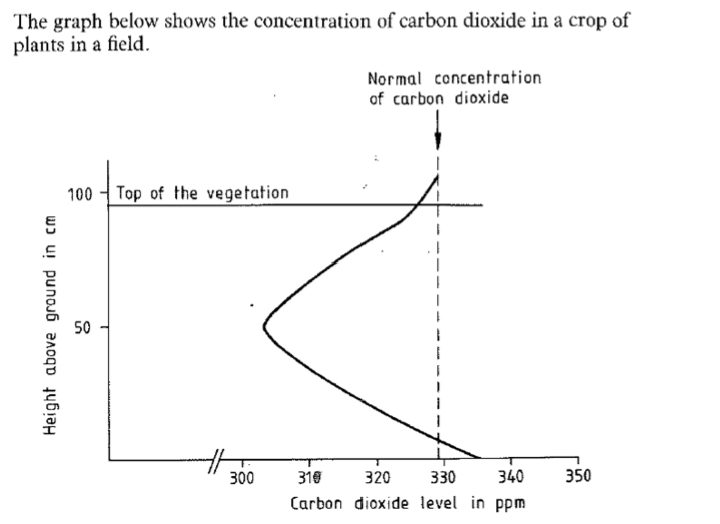
Why is the concentration of carbon dioxide at ground level greater than that normally found in the air?
???
9.2 How does the abiotic factor; oxygen levels for aquatic animals affect the community?
Oxygen from the air and oxygen produced by aquatic animals dissolves in the water. Without this, aquatic animals would suffocate and die.
Polluted waters often have low levels of oxygen, this means that only certain species can survive there such as sludge worms.
9.2 Why are sludge worms bioindicators species?
Because their presence or absence can inform us of the condition of the habitat.
9.2 What species are indicators of clean water?
stonefly nymph and mayfly larva
9.2 What species are indicators of some pollution?
freshwater shrimp and caddis fly larva
9.2 What species are indicators of moderate levels of pollution?
Bloodworm and water louse
9.2 What species are indicators of high levels of pollution?
sludge worms and red-tailed maggot
9.2 What is an indicator of very high levels of pollution?
no living insects
9.2 What are biotic factors?
a living factor in an environment such as competition, predation and disease
9.2 What are the 2 main biotic factors?
competition and predation
9.2 How does the biotic factor; food availability impact the community?
All animals require food to live.
Areas like rainforests with rich supplies of food have more species of life than other areas like deserts and the Polar Regions
9.2 How does the biotic factor; new predators affect the community?
The arrival of new predators in an ecosystem can have devastating effects.
In balanced ecosystems, predators and prey have evolved together so predators can catch enough food to survive, but not too many that they kill all the food.
Introducing new predators can cause a rapid decline in numbers of prey, which reduces the food supply for existing predators.
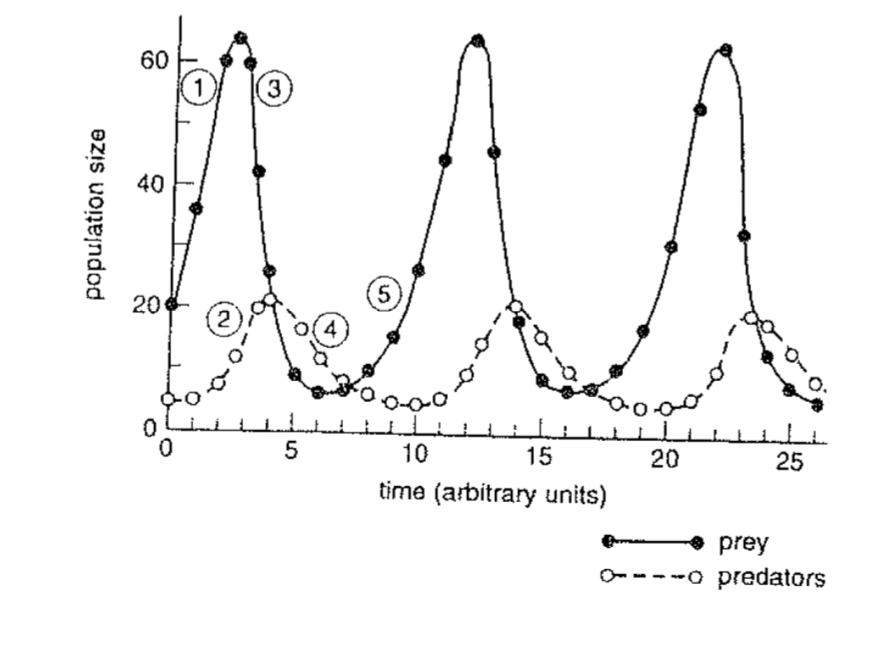
9.2 Explain what is happening to the prey population at 1
Increases as low predators

9.2 Explain what is happening to the predator population at 2
Increases as there is lots of prey (food)
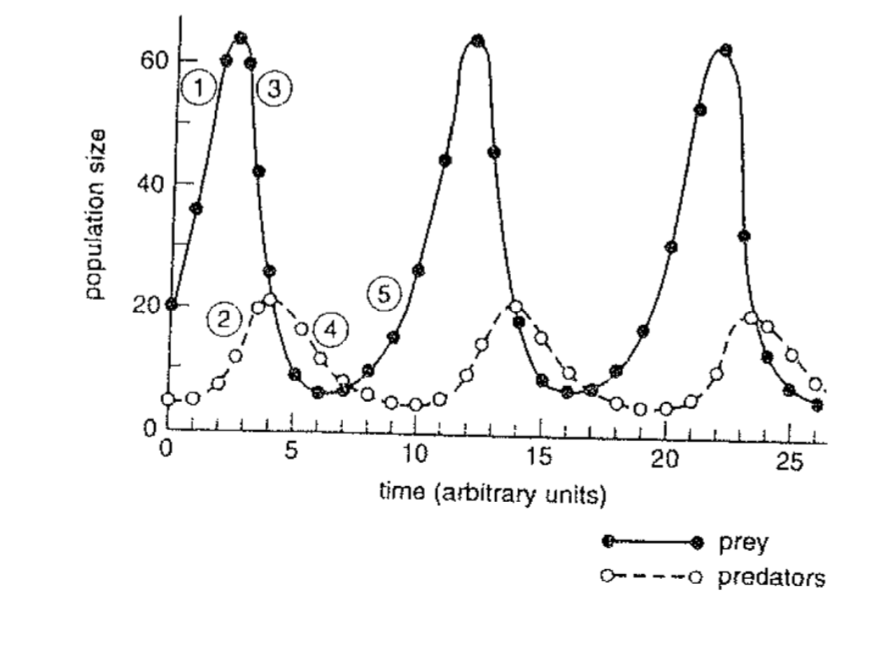
Explain what is happening to the prey population at 3
Decreasing due to high predator numbers

Explain what is happening to the predator population at 4
Dropping due to lack of prey (food)
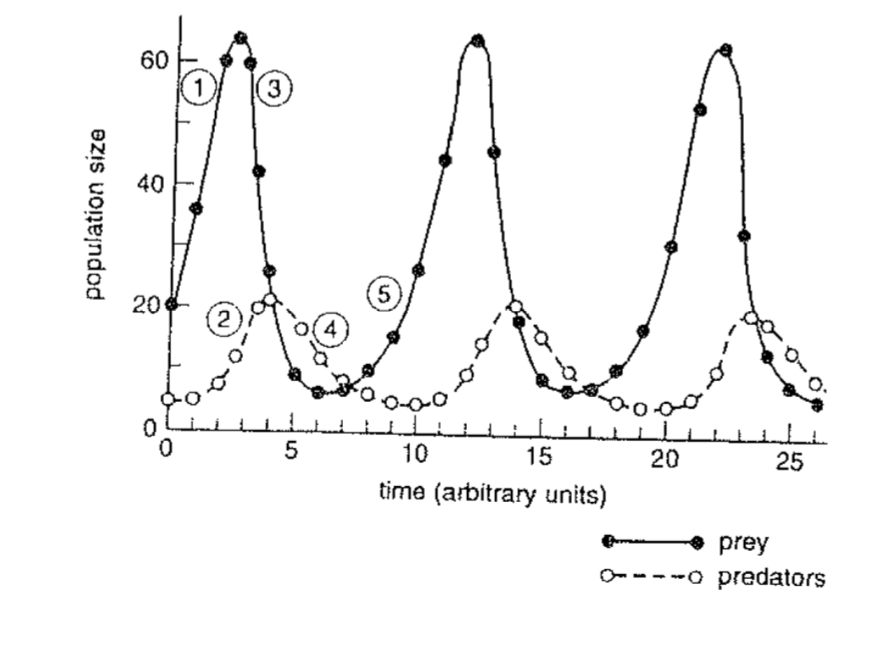
Explain what is happening to the prey population at 5
Increasing as there are less predators
9.2 How does the biotic factor; new pathogens affect the community? Give an example
When organisms inhibit new ecosystems they often bring new pathogens.
E.g Europeans firs colonised North America, and introduced new pathogens like influenza virus.
9.3 What does the idea of interdependence in a community mean?
All the organisms in an ecosystem depend on each other. If the population of one organism rises or falls, then this can affect the rest of the ecosystem.
Often very small changes to the ecosystem have large consequences, which can be difficult to predict, meaning that all organisms in the ecosystem are dependent upon each other. This is called interdependence
9.3 here is a simple food chain:
grass → rabbit → fox
What would happen to the rabbits and grass if the foxes were all killed?
The population of rabbits would increase because they are no longer being eaten.
As a result the amount of grass would decrease because the increased population of rabbits would consume more of it.
9.7 What are trophic levels?
they are used to describe the feeding relationship between organisms.
9.7 What is the source of energy for all life on earth?
The Sun
9.7 Where does the sun flow to? And in what form? What happens next?
the first trophic level (producers) in the form of light.
The producers then convert the light energy to chemical energy and it flows to one consumer to the next.
Eventually all the energy is passed on to the environment
9.7 Name the 5 tropic levels
producer
primary consumer
secondary consumer
tertiary consumer
quaternary consumer
9.7 When is energy lost to the environment?
When heat energy is transferred from organisms to their surroundings
9.7 What is a food chain?
A simple way to show the feeding interacting between organisms in a community.
It shows the transfer of energy from one organism to the next
9.7 What is the source of all the energy in a food chain?
light energy from the sun
9.7 What do the arrows in the food chain represent?
the transfer of energy from one trophic level to the next
9.7 What is a food web?
A food web is a network of interconnected food chains.
They are more realistic in showing the connections between organisms within an ecosystem.
9.7 What are the three forms of pyramids?
pyramids of number
pyramids of biomass
pyramids of energy transfer
9.7 What does a pyramid of number show?
How many organisms are at each tropic level of a food chain.
The width of the box indicates the number of organisms at that trophic level.
9.7 What are the units for pyramids of number?
number of organisms
eg 6 rabbits
9.7 Do pyramids of number always have a pyramid shape? Explain your answer
No
-the size of the of the organism is also important
-one larger organism, like an oak tree in the pyramids below contains enough energy to support many smaller organisms (the insects)
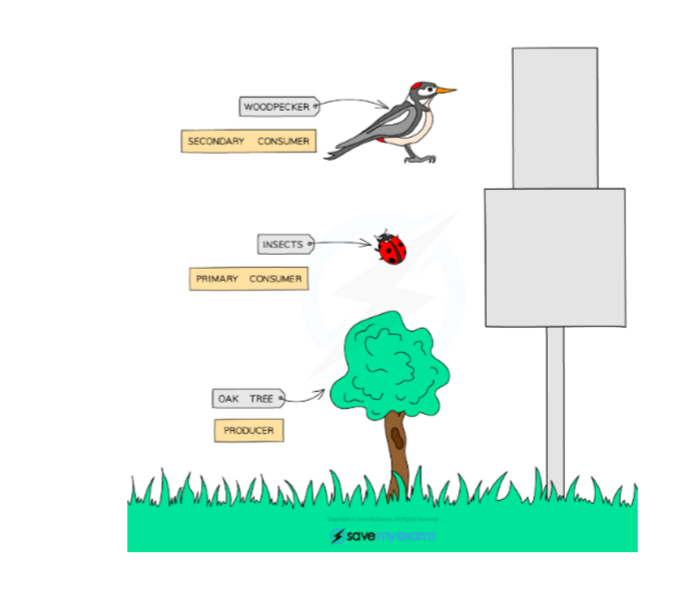
9.7 What is a key rule to follow when drawing pyramids?
You cannot change the trophic level of the organisms- they must stay in the same order as in the food chain.
9.7 What do pyramids of biomass show?
Shows how much mass the creatures at each level would have without including the water in the organisms (their dry mass).
9.7 Do pyramids of biomass always have a pyramid shape?
Yes, because the mass of organisms have to decrease as you go up a food chain.
For example it is impossible to have 10kg of grass feeding 50kf of voles.
9.7 What are the units for biomass?
g/m²
9.7 Why is the pyramid of biomass the best way to show interdependence?
It shows the quantity of the plant and animal material at each level of the food chain
9.7 What is biomass
a measure of the total mass of each living organism in each tropic level
9.7 What does the pyramid of energy transfer show?
The amount of energy contained within the biomass of individuals within different trophic levels
the area of each box represents the quantity of energy present
these pyramids have a wide base (due to the amount of energy contained within the biomass of producers)
9.7 As you move up the pyramid to higher tropic level what happens to the quantity of energy?
It decreases because not all the energy is transferred to the biomass of the next trophic level
9.7 How much of the energy is transferred to the biomass of the next trophic level in pyramids of energy transfer?
roughly 10% of the energy is passed on and 90% is lost
9.7 Where is the 90% of the energy lost to? Give 5 things
1) Energy lost to surroundings
2) Not all the organism is actually digested (e.g humans don’t eat the bones of meat)
3) Used for chemical processes such as respiration
9.7 What do producers do to the light energy they attain from the sun?
During photosynthesis they convert the light energy to chemical energy by converting carbon dioxide and water to glucose and oxygen
9.7 What to the producers then use this glucose to do?
to produce their own biomass (store of chemical energy) during respiration
9.7 In terms of biomass, what happens when a primary consumer eats producers?
They break down the bio mass of the producer (digestion) and use the chemical energy to increase or sustain their own biomass, this pattern increases as you go through the trophic levels
9.7 What happens to the amount of biomass as you go up the food chain?
The biomass decreases due to the gradual loss of energy
9.7 When the chemical energy is transferred from one trophic level to another what is also transferred?
When when the chemical energy is transferred from one trophic leave to another, bio mass is also transferred
9.7 Why do these losses of energy occur?
organisms rarely eat every part of the organism they are consuming
not all the ingested material is digested and absorbed, some is excreted
energy is used for respiration
energy is used for movement
energy is used for growth and repair
some absorbed material is lost by waste:
carbon dioxide and water are waste products of respiration
water and urea are the waste products in the urine, which is produced when protein is broken down
9.8 What is the equation to calculate the efficiency of energy and biomass transfers?
e.g (138/1450) × 100 + 9.52%
